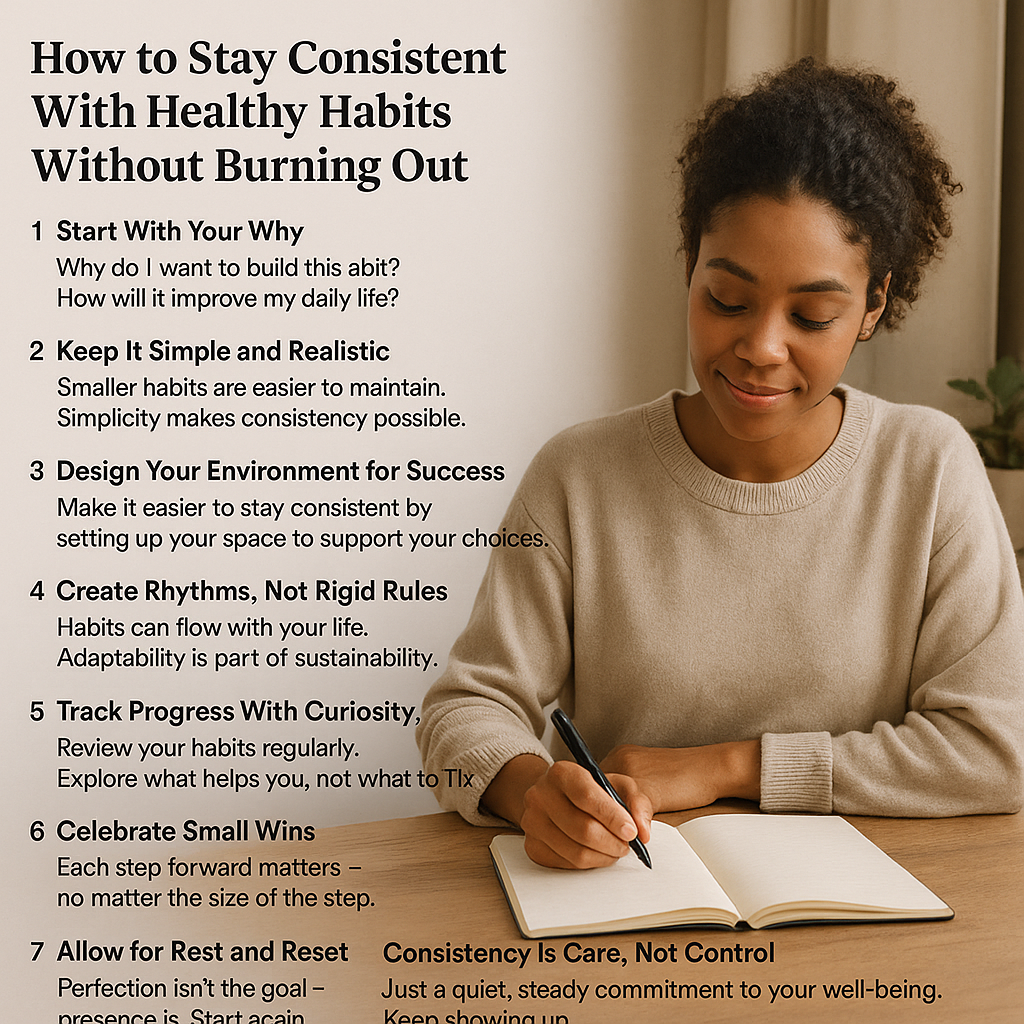Building healthy habits is powerful — but maintaining them is where transformation truly happens. The challenge? Many people start with motivation but end up overwhelmed by unrealistic routines or pressure to be perfect. True wellness isn’t about intensity — it’s about consistency. And consistency thrives when you learn how to create habits that fit into your real life, not the ideal one.
The Myth of All-or-Nothing
One of the biggest barriers to consistency is perfectionism. We think:
- “If I can’t do it all, I shouldn’t do it at all.”
- “I missed one day, so I failed.”
- “I need to go harder to make real progress.”
This mindset leads to burnout, guilt, and eventually giving up. Instead, shift to a sustainable model: small, steady, and self-aware.
Step 1: Start With Your Why
Consistency begins with clarity. Ask yourself:
- “Why do I want to build this habit?”
- “How will it improve my daily life?”
- “What value does it reflect about who I want to be?”
Your why is the fuel that keeps you going when motivation fades.
Step 2: Keep It Simple and Realistic
Healthy habits don’t need to be dramatic to be effective. In fact, smaller habits are easier to maintain. Try:
- 5 minutes of stretching instead of an hour-long workout
- Drinking a glass of water first thing in the morning
- Journaling 2 sentences instead of a full page
- A 10-minute walk instead of a long run
Simplicity makes consistency possible.
Step 3: Design Your Environment for Success
Your surroundings can make or break a habit. Make it easier to stay consistent by:
- Keeping your yoga mat visible
- Setting a water bottle on your desk
- Placing your journal beside your bed
- Prepping healthy snacks in advance
Let your space support your choices.
Step 4: Create Rhythms, Not Rigid Rules
Consistency doesn’t mean doing the same thing at the same time every day. It means returning to the habit regularly — even if the rhythm changes. Be flexible:
- If you can’t do your full routine, do a shorter version
- If your schedule shifts, adjust rather than abandon
- Think of habits as flowing with your life, not against it
Adaptability is part of sustainability.
Step 5: Track Progress With Curiosity, Not Criticism
Instead of rigid goals, track your habits to stay mindful and motivated. Ask weekly:
- “What helped me stay consistent this week?”
- “Where did I struggle, and why?”
- “What small adjustment would help next time?”
This builds awareness without guilt.
Step 6: Celebrate Small Wins
Consistency is built on momentum — and momentum needs encouragement. Celebrate:
- Showing up, even when it was hard
- Doing a shorter version of your habit
- Noticing positive changes in mood, energy, or mindset
Each step forward matters.
Step 7: Allow for Rest and Reset
Rest is part of the process. You don’t have to be perfect — you have to be present. When you miss a day (or a week), simply start again. Guilt is not a motivator. Self-kindness is.
Step 8: Build Identity, Not Just Discipline
Instead of forcing yourself, begin to say: “I’m the kind of person who cares for my body.”
“I’m someone who protects their peace.”
“I value showing up for myself.”
When habits become part of your identity, they last longer — because they feel like home.
Final Thought: Consistency Is Care, Not Control
Staying consistent doesn’t mean pushing yourself to the limit — it means returning to what matters. Again and again. Without drama. Without pressure. Just a quiet, steady commitment to your well-being. You don’t need to do more. You need to keep showing up — for your body, your mind, your peace. That’s enough. That’s everything.
